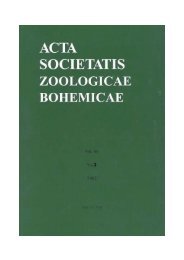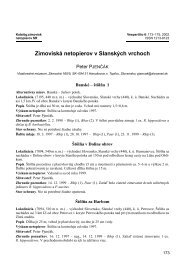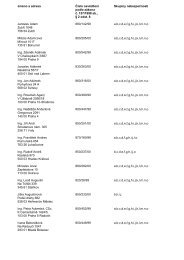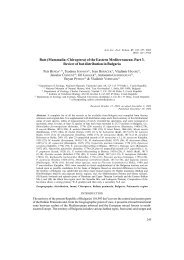Create successful ePaper yourself
Turn your PDF publications into a flip-book with our unique Google optimized e-Paper software.
Bulletin of the Czech Geological Survey, Vol. 77, No. 3, 167–182, 2002© Czech Geological Survey, ISSN 1210-3527Arthropods of Burgess Shale type from the Middle Cambrian of Bohemia (Czech Republic)IVO CHLUPÁČ 1 – VRATISLAV KORDULE 21 Institute of Geology and Palaeontology, Charles University, Albertov 6, 128 43 Praha 2, Czech Republic2 Dlouhá 104, 26 101 Příbram III, Czech RepublicAbstract. Rare non-trilobite arthropods, mostly with affinities with the Burgess Shale fauna, are described from the Middle Cambrian Jince Formationof the Barrandian area, Central Bohemia (Czech Republic): Tuzoia sp., another large Tuzoia-like arthropod (probably a new genus), Proboscicarishospes sp. n., Helmetia? fastigata sp. n., and Forfexicaris? sp. The status of Pilocystites primitius Barrande, 1887, formerly ranged withechinoderms but here recognized as a Tuzoia fragment, is discussed. Most of described arthropods (except Forfexicaris? sp.) are thought to be nektobenthicanimals of a shallow-water environment, possibly tolerant to some salinity fluctuations. Relationships, particularly to North American faunas,indicate open migration possibilities between Laurentia and peri-Gondwana regions during the Middle Cambrian.Abstrakt. Ze středního kambria Barrandienu (převážně jineckého souvrství) jsou popsány vzácné zbytky arthropodů se vztahy k burgesskýmbřidlicím západní Kanady. Jde o zástupce rodu Tuzoia Walcott (zde označené Tuzoia sp., sem patří i zbytek popsaný jako Pilocystites primitius Barrande,1887, dosud s rezervou řazený k ostnokožcům), dále zbytek jiného velkého členovce příbuzného rodu Tuzoia (patrně nový rod), prvý mimoamerickýzástupce rodu Proboscicaris Rolfe (P. hospes sp. n.) a čeledi Helmetiidae – Helmetia? fastigata sp. n. K arthropodům nejistéhosystematického postavení jsou řazeny kruhovité štítky prozatímně označené jako Forfexicaris? sp. Většina popsaných zbytků pochází ze svrchní částijineckého souvrství z okolí Jinců (blízké podloží zóny Paradoxides gracilis až zóna Ellipsocephalus hoffi-Rejkocephalus), přibližný ekvivalent baltickétrilobitové zóny Paradoxides paradoxissimus a báze zóny P. forchhammeri. Organismy jsou hodnoceny jako nektobentózní, snad tolerantní i k salinitnímvýkyvům, Forfexicaris? sp. mohl patřit k pelagickým formám. Vztahy k severoamerickým faunám svědčí o otevřených možnostech migracímezi Laurentií a perigondwanskými oblastmi během středního kambria.Key words: Arthropoda, Phyllocarida and incertae sedis, Middle Cambrian, Barrandian area, Czech RepublicIntroductionThe marine Middle Cambrian strata of the Jince Formationin the Barrandian area, Central Bohemia, areworld-famous particularly for well preserved trilobite andechinoderm faunas, accompanied by locally frequent ichnofossils,hyolithids, brachiopods, and acritarchs. Representativesof other fossil groups such as ostracods,gastropods, foraminifers, and algae as well as of someproblematical groups are rare. Remains of large non-trilobitearthropods are also very rare finds and mostly werenot correctly recognized in the past.Collecting activity during the last fifty years, particularlyin the Jince area, has revealed some remarkable findsof non-trilobite arthropods with relationships to the famousMiddle Cambrian Burgess Shale fauna of North America.These are the subjects of the present report.Regrettably, the new materials are incomplete in manyrespects, frequently allowing only a tentative determinationat the generic level. Consequently, open nomenclatureis commonly used.The reference material is housed in the collections ofthe National Museum, Prague (inventory numbers prefixedby L), in the collections of the Czech GeologicalSurvey, Prague (inventory numbers prefixed by VK = collectionof Vratislav Kordule, SZ = coll. M. Szabad). Threespecimens from the collection of the late Mr. J. Bouška aredeposited in the West Bohemian Museum in Plzeň (numbersprefixed by MP-S).The laboratory work was partly assisted by a Ministryof Education grant No. MSM-113100006.Systematic partPhylum ArthropodaClass Malacostraca Latreille, 1806Subclass Phyllocarida Packard, 1879Order and Family uncertainGenus Tuzoia Walcott, 1912Type species: Tuzoia retifera Walcott, 1912,Burgess Shale, Middle Cambrian.Diagnosis (comp. Rolfe 1969): Carapace bivalve,hinge line distinct. Outline of carapace valves subelliptical,with distinct anterior carapace horn. Sculpture reticulate,prominent lateral ridge, carinate, with smaller reticulae thanon main areas of valves. Spines or spinules of differentlength and number protrude from the margin of valves (exceptthe anterior margin, spines may occur also on the lateralridge). Doublure along the ventral margin is flat.Remarks. Tuzoia was introduced by Walcott (1912)in describing the Burgess Shale fauna. Other species of thisgenus were described later from North America (particularlyby Resser 1930, Robison and Richards 1981), China(Endo and Resser 1937, 1957) and South Australia (Glaessner1979). No representatives have been so far reported167








